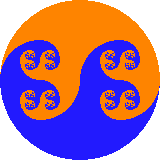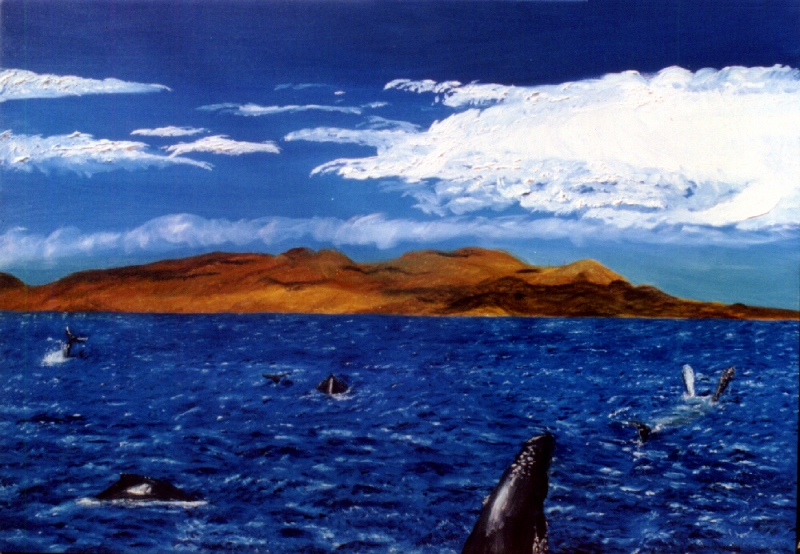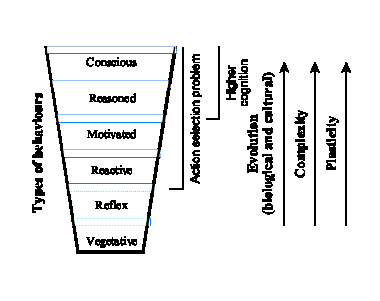
"As much as you go, and even if step by step you proceed through all the ways, you will not find the limits of the soul, so deep the lambdagamma has penetrated in her"
--Heraclitus

"La Incomprensión del Hombre". Carlos Gershenson, Mexico City, 1998. Oil on canvas, 100 x 70 cm.
Why engineer systems simulating living creatures and their societies? Well, it helps us understand better those living creatures and their societies. But in the process, we obtain artificial creatures with the same capabilities as the ones simulated from the living creatures. So we have a benefit, both for engineering and biology (Maes, 1991).
Also, understanding adaptive behaviour paves the road for understanding higher cognition.
"The more we can find out about how our brains evolved from those of simpler animals,
the easier the task will be"
--Marvin Minsky
We can classify adaptive (animal) behaviour in the following types of behaviours: vegetative, reflex, reactive, and motivated behaviours. Vegetative behaviours would be the ones that are in the organism by "default", such as breathing, heart beating, metabolizing, etc. They can be seen as implicit, internal behaviours, that are not noticed by an observer because they are always there. They do not require to be modelled, because they are "obvious (1)". Reflex behaviours would be action-response-based behaviours, such as the response to a burn, that is to move the injured part from the heating source. We would argue that bacteria's behaviours are controlled only by reflex behaviours. We could say that in vertebrate animals, reflex behaviours are controlled at a medular level. We can see that there is no problem of action selection in the previous behaviour types, as it is in the following. Reactive behaviours would be the ones that depend strongly of an external stimulus, or a set or sequence of external stimuli (McFarland, 1981). For example, if I perceive a tasty chocolate cake, even if I am not hungry (no internal motivation), I might reactively eat it; but also I might decide not to eat it, because I have other internal needs to be satisfied (such as vanity). Most simple social behaviours could be classified as reactive, such as flock and school formations, stampedes, and crowd behaviours. This is because each individual in the society imitates the neighbours, but without the "need" of doing so (it is not that they do not need it, but that they can live without it). We can see that reflex and reactive behaviours are similar, but the difference is that the reactive behaviours go through an action selection process, which may cause that they will not be executed, and the reflex behaviours will always be executed. Motivated behaviours would be the ones that need an internal motivation and an external stimulus (which might be also the absence of a stimulus) in order to be executed. For example, the searching for water by an animal may be caused by his thirst. We understand by internal motivations those that are needed to be satisfied so that the entity will be in a "comfort zone". Not only those motivations needed for survival are internal motivations. Emotions can also be seen as internal motivations, or as expressions of internal motivations. We should note that in reactive behaviours, there might be motivations that we do not perceive. That is why the borders between the different types of behaviours are not sharply defined and are fuzzy, but this is not important for our purposes.
We hold that in terms of evolution, first were vegetative behaviours, then reflex, then reactive, then motivated, then reasoned, and then conscious ones. Reasoned behaviours require concepts (symbolic representations), and manipulation of those concepts in order to select the behaviour. Some might not have any differences, for an outside observer, from the previous ones. But reasoned behaviours require concepts and a logic in the action selection process. So, in individuals with reasoned behaviours, motivated and reactive behaviours might or might not be reasoned. But there are plenty of complex reasoned behaviours that require of concepts and logic in order to be achieved. Extreme examples would be designing a spaceship and the planning of a perfect murder. We can see that reasoned behaviours require of a language and a culture, in order to evolve from previous behaviours. Also here the border is fuzzy, because there can be many different degrees (complexities) of reasoned behaviours. We can say that conscious behaviours are the ones that are executed while being aware of them, without falling in the debate of what and where consciousness is. This might be also seen as reasoning about what we are reasoning (similar to what Dennet calls a second order intentional system (Dennet, 1987)). Reasoned and conscious behaviours imply higher cognition. We can see that the more evolved types of behaviours are more complex. We also argue that plasticity is increased through the different levels of behaviours as well. This is, more evolved behaviours adapt (learn) faster to changes in the environment. More basic behaviours should not be too plastic, because they are in charge of more vital functions (e.g. if we would need to be conscious of our breathing, we could forget about it). Figure 1 shows graphically the previous classification.

We believe that, in order to model plausibly reasoned behaviour in an open, unpredicted, non deterministic environment, we should model first convincingly reflex, reactive, and motivated behaviours. Reasoned behaviours need the other behaviours, not only because reason (and higher cognition) evolved from adaptive behaviour, but because we can distinguish a hierarchy among the types of behaviours described above. For example, if I am in a night club, hierarchically, first, I will breathe to stay alive (vegetative); then, I will move my foot if someone steps on it (reflex); then, I will probably clap if everyone begins to clap (reactive); then, I will ask a girl for a dance if I feel attracted to her (motivated); then, I will begin to think about what to speak with her (reasoned); and finally, I will ask myself what am I doing in such a place (conscious). We can see that the less complex types of behaviours will dominate the more complex, not only because the execution of the more complex behaviours (in most cases) does not prevent the execution of the less complex (I can keep breathing while moving my foot, I can reflexively move my foot while clapping and dancing, etc.), but also because the more complex types of behaviours need of the execution of the less complex in order to be executed (I need to breathe to live, I need to move my foot to dance, I need to like a girl to think how to seduce her, and I need to have all the previous experiences in order to be aware of them and rethink what I am doing). Also, the low plasticity in the less evolved behaviours makes them hard to control by the more evolved. For example, we can control hunger (motivated) with reason more or less successfully, but it is harder to control our dance steps (reactive) in a different way than we are used to, and it is very hard indeed not to scream if some part of us is burning (reflex). Behaviours that took generations to be learned by evolution are harder to forget than behaviours learned in one day.
Each type of behaviour solves a problem. The next behaviour was evolved over the previous without losing the capability of solving previous problems. We believe we should engineer our artificial systems in the same manner: build a subsystem to solve a problem. Then build over the previous subsystem another one to solve a new problem, but without losing the capabilities of solving the first problem(s), in a bottom-up fashion. By following the steps of natural evolution, we can simulate more completely creatures created by it.
Before being humans, we are animals. If we want to simulate human reasoning, we need to simulate properly animal behaviour. Also, we would need a culture, a language, and a society to obtain reasoned behaviour from adaptive behaviour.
In the present work, we join the effort of the community to model adaptive behaviour, in order to set a behavioural basis of cognition. We do this by engineering artificial societies of intelligent agents, to understand intelligence emerging from adaptive behaviour, building artificial societies on the way.
"Objects do not depend on the concepts we have of them"
A "problem" in scientific research is that different people are working in similar concepts in parallel, so they can name the same thing with different names, or different things with the same names. We should just do not care so much about terms (2). We should care about the research itself. Since objects do not depend on the concepts we have of them, we can study objects without putting much attention in the definitions of the concepts (not that it is not important). Other people can discuss "how should we call things". John Locke said it well: "Words should not be taken as adequate portraits of things, because they are no more than arbitrary signs of certain ideas".
It is because of this that in this work we will not give sharp definitions of our concepts, only notions.
Objects can have many different, and even contradictory concepts representing them (e.g. information (Wiener, 1948; Shannon, 1948), complexity (Bar-Yam, 1997), etc.). No matter how similar or diverse are these concepts, the objects referred by them will not be affected. This is because they are independent of them.
How can we make science then? We need to have agreements. We do not have absolute truths or falseness. Our universe appears to be relative. We can say that our agreements are our beliefs, and that our beliefs are the axioms of our thought. As Kurt Gödel proved (Gödel, 1931), all systems based in axioms are incomplete. Also, Alan Turing proved that "there can be no general process for determining wether a given formula of the functional calculus K is provable" (Turing, 1936). This can be generalized saying that there is no method to say if a theorem in an axiomatic systems is provable, or not provable in a finite time. These issues imply that theorems derived from axioms cannot prove the axioms. These axioms are agreements. But we cannot be sure of them. One example can be seen with multidimensional logic (Gershenson, 1998a; Gershenson, 1999), a paraconsistent logic (Priest and Tanaka, 1996) that is able to handle contradictions. This is because we disposed the axiom of non contradiction of consistent logics. After this we built our logic on our own axioms (allowing contradictions), and the result is there. We can understand contradictions and map them to consistent logics.
This is not a thesis in philosophy of science, so we will just conclude saying that in order to obtain the agreements needed in science, we need to doubt of everything. We cannot trust blindly our beliefs because we cannot prove them, neither anything based on them.
The objective of this thesis is to contribute to the understanding of the behavioural basis of cognition. We do this in three ways:
We expose a behaviours production system (González, 2000) that is able to simulate many properties of adaptive animal behaviour. This gives the community a tool for engineering adaptive artificial creatures, and also contributes to the understanding of animal adaptive behaviour itself.
We present a simple social model for imitation and induction of behaviours. This helps us understand better social systems, and also gives us a tool for engineering artificial social systems.
Finally, we build a Behaviours Virtual Laboratory (Gershenson, González, and Negrete, 2000b) incorporating the mentioned behaviours production system and social model in artificial animals (animats (Wilson, 1985)). This allows us to experiment and simulate conditions from real and artificial systems.
This thesis has been structured in the following way:
Chapter 1 makes an introduction to Behaviour-based Systems, their background in artificial intelligence, their properties, and areas where they have been applied.
In Chapter 2 we make an introduction to complex systems, to then fall into the theme of Artificial Societies, their characteristics, and previous work related with them.
Chapter 3 deals with Behaviour-based Intelligence. We first make a short review of behaviour-based systems for the control of artificial creatures. Then we present the Behavioural Columns Architecture (BeCA) (González, 2000), a context-free behaviours production system, and its properties.
In Chapter 4 we introduce our simple social model of imitation and induction (I&I), which allows social processes to emerge using a behaviour-based approach.
In Chapter 5 we present our Behaviours Virtual Laboratory (BVL) (Gershenson, et. al., 2000b), its components and functionality.
Chapter 6 consists of two series of experiments elaborated in our BVL: one to test intelligence emerging from BeCA, and another to test social phenomena emerging from the interactions of the animats socializing through I&I.
At the end of the thesis we include a brief glossary, giving a notion of important terms used through the thesis.
This thesis is available in PDF format at https://bingweb.binghamton.edu/%7Ecgershensong/unamjlagunez/asia, with images in colour.
Figure 2 shows a graphical structure of the thesis.
1. They are obvious at the level of the individual, for example, hunger decreasing because of feeding is obvious at an individual level, but quite complex at a protein or cellular level.
2. As Pattie Maes suggested me.
Carlos Gershenson